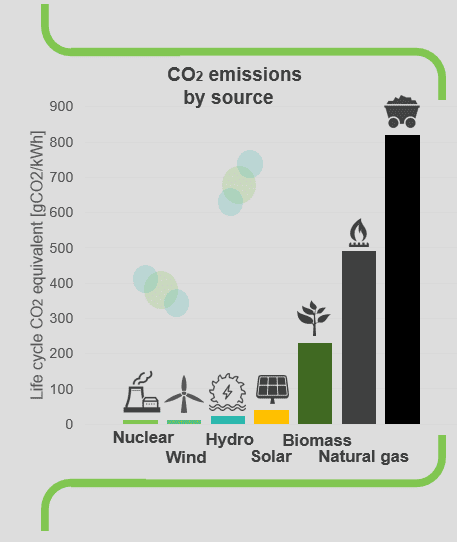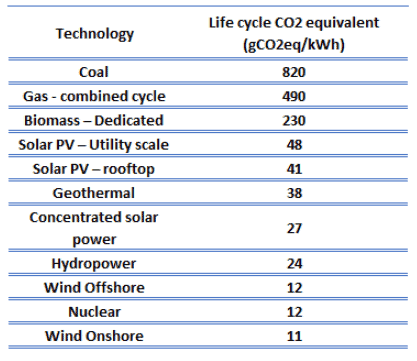What is the low-carbon balanced energy mix?
Generation and consumption must be balanced across the entire grid because energy is consumed as it is produced.
Variable renewable energy sources are not dispatchable due to their fluctuating nature, such as wind power and solar power. When it’s cloudy or the wind isn’t blowing, the grid needs more energy from other sources.
The MIT analysis shows a big share of nuclear, a big share of renewables, and some storage is the best mix that is low-carbon, reliable, and at the lowest cost.
Transitioning to a low-carbon economy presents a significant opportunity and an enormous challenge. This transition must be based on sustainable low-carbon primary energy sources suitable for a given place.
There are two general rules for making the transition to a low-carbon economy:
- The proposal of a sustainable energy mix must always respect physical laws.
- The proposal of a sustainable energy mix must always take into account the specific geographical conditions of a given country. For example, coastal countries have different options than inland countries.
Experts, physical laws, and natural conditions of individual countries are sometimes ignored when designing national and international energy strategies. Although renewables are the main sustainable primary resource, their intermittency must be considered. It’s all about the balanced energy mix. Using a diverse portfolio of energy resources allows electric companies to balance the output of variable sources like solar and wind and use the most cost-effective resources available to provide customers with the safe, reliable, and affordable energy they need. Ensuring reliability under all circumstances, including weather extremes and emergencies, requires energy companies to use 24/7 energy sources, such as nuclear energy, natural gas, hydropower, and coal, to generate reliable energy consistently.
Greenhouse gas emissions of energy sources
 In 2014, the Intergovernmental Panel on Climate Change harmonized the carbon dioxide equivalent (CO2e) findings of the major electricity generating sources in use worldwide. Coal is the worst emitter, followed by natural gas, with solar, wind, and nuclear all low-carbon. Hydropower, biomass, geothermal, and ocean power may generally be low-carbon, but poor design or other factors could result in higher emissions from individual power stations.
In 2014, the Intergovernmental Panel on Climate Change harmonized the carbon dioxide equivalent (CO2e) findings of the major electricity generating sources in use worldwide. Coal is the worst emitter, followed by natural gas, with solar, wind, and nuclear all low-carbon. Hydropower, biomass, geothermal, and ocean power may generally be low-carbon, but poor design or other factors could result in higher emissions from individual power stations.
Why a balanced energy mix?
Generation and consumption must be balanced across the entire grid because energy is consumed as it is produced. Energy is stored in the immediate short term by the rotational kinetic energy of the generators. With the move to more wind and photovoltaics, the inertia in the systems will be reduced. System inertia refers to the kinetic energy stored in large generators’ rotating mass, such as those found in fossil-fuel-based power plants. System inertia is vital for maintaining a stable frequency level. Therefore, a low-carbon balanced energy mix must be based on:
 Variable renewable sources. Renewable energy sources are abundant and have very low or zero carbon emissions, making them environmentally friendly. Variable renewable energy sources are not dispatchable due to their fluctuating nature, such as wind power and solar power. When it’s cloudy or the wind isn’t blowing, the grid needs more energy from other sources. Characteristics of variable renewables include their unpredictability, variability, small size, low running costs, and the fact that they are constrained to a certain location. These provide a challenge to grid operators, who must make sure supply and demand are matched. Solutions include energy storage, demand response, availability of overcapacity, and sector coupling. The higher the share of these sources in the energy mix, the higher the demand for transmission and energy storage systems.
Variable renewable sources. Renewable energy sources are abundant and have very low or zero carbon emissions, making them environmentally friendly. Variable renewable energy sources are not dispatchable due to their fluctuating nature, such as wind power and solar power. When it’s cloudy or the wind isn’t blowing, the grid needs more energy from other sources. Characteristics of variable renewables include their unpredictability, variability, small size, low running costs, and the fact that they are constrained to a certain location. These provide a challenge to grid operators, who must make sure supply and demand are matched. Solutions include energy storage, demand response, availability of overcapacity, and sector coupling. The higher the share of these sources in the energy mix, the higher the demand for transmission and energy storage systems.- Controllable sustainable sources. Controllable sustainable sources produce low-carbon energy on demand at the request of power grid operators, according to market needs. These sources include nuclear energy, hydropower, biomass, or relatively constant sources, such as geothermal power. Since controllable sustainable sources can follow the grid load, they drastically reduce the demands of variable renewables on the transmission and energy storage systems.
Cost-effective energy storage system. Common examples of energy storage are the rechargeable battery, which stores chemical energy readily convertible to electricity to operate a mobile phone; the hydroelectric dam stores energy in a reservoir as gravitational potential energy. Note that these systems do not produce net energy. Moreover, energy storage is associated with energy losses, around 20%. Energy storage systems are usually very expensive; therefore, a cost-effective solution includes only peak load storage. - Cost-effective production of energy carriers. This is probably the most challenging part of a low-carbon economy. The industrial and transport sectors consume more fossil resources than the entire electricity generation sector. In practice, the transition of the industrial sector and transportation to low-carbon primary sources means a transition to hydrogen, electricity, or e-fuels. But their production must be based only on low-carbon primary resources. Because the dominant sustainable sources produce electricity as an energy carrier, it will be necessary to double the electricity generation capacity in practice. Sustainable primary energy sources for residential, industrial, and transportation sectors:
- Solar energy. The primary energy source for solar, wind, hydropower, and biofuels is the Sun, and solar energy is the primary sustainable source of energy.
- Nuclear energy.
- Geothermal energy.
- Tidal energy
A 2018 study (“The Role of Firm Low-Carbon Electricity Resources in Deep Decarbonization of Power Generation”) suggested a new classification of energy generation sources, which accounts for a fast increase in penetration of variable renewable energy sources, which results in high energy prices during periods of low availability:
- “Fuel-saving” variable renewable energy has near-zero variable costs and zeroes fuel costs by using the power of wind, Sun, and run-of-river hydropower. With a large share of these sources, “capacity needs are driven by periods with low VRE availability.” Therefore, their proposed role is to replace other high-variable cost sources during periods when they are available.
- “Fast-burst” are energy sources that can be instantly dispatched during periods of high demand and high energy prices but are poorly performing for long-term continuous operations. These include energy storage (batteries), flexible demand, and demand response.
- “Firm” low-carbon sources provide stable energy supply during all seasons and periods up to weeks or months. They include nuclear power, hydro plants with large reservoirs, fossil fuels with carbon capture, geothermal, and biofuels.
Current nuclear power plants have traditionally been considered a baseload source of energy. The reactors run as often as possible to spread their enormous fixed costs over the largest number of kilowatt-hours. Unlike gas turbines, which can be turned on and off in seconds to “follow the load,” reactors take an hour or more to cut their production in half. It’s not that reactors can’t follow the load; they’re just slower. Current nuclear reactors can follow the load and do follow it because they have to.
Electricity Generation as Critical Infrastructure
Why is energy storage so difficult?
Nowadays, energy storage seems simple. For example, many companies offer photovoltaic systems along with battery storage. Energy storage to cover daily consumption has an expensive but easy solution. However, the problem is energy storage to cover the whole year and seasons. For most countries, the highest energy consumption is in autumn and winter, when there is little wind inland and little Sun. Consider, for example, a small residential home that consumes about 3,000 kWh of electricity annually and about 15,000 kWh of natural gas for space heating. Note that more than half (51% in 2015) of a household’s annual energy consumption is for just two energy end uses: space heating and air conditioning. These seasonal and energy-intensive uses vary significantly by geographic location, home size, structure, equipment, and the fuel used. Residential homes consume about 91 kWh (3,000/365 + 15,000/180) energy per winter day. As you can see, space heating dominates in winter. This would require a large overcapacity of solar power; otherwise, these residential homes need to be connected to an external energy source.